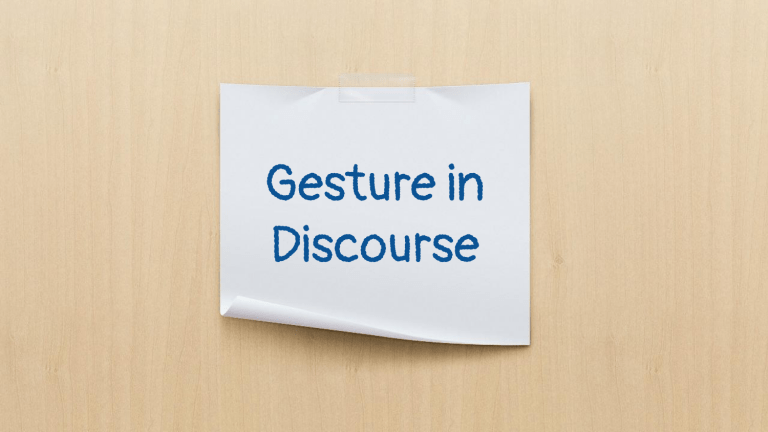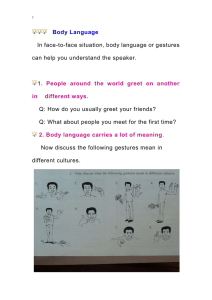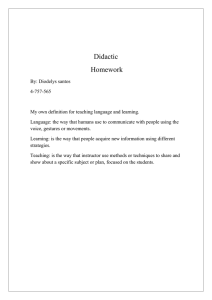
Gesture in Discourse Inside the utterance, we will find information, and if we know how to unpack the utterance, we will find discourse. It is a type of nonverbal communication in which physical behaviors, as opposed to words, are used to express or convey the information. Such behavior includes facial expressions, body posture, gestures, eye movement, touch and the use of space. Body language 3 Two women talking to eachother; Notice the woman in blue has arm next to her body, whilst the other uses hers to gesticulate, both signs of body language. 4 It is an integral part of body language and the expression of emotion. An accurate interpretation of it relies on interpreting multiple signs in facial expressions combination- such as the movement of the eyes, eyebrows, lips, nose and cheeks- in order to form an impression of a person’s mood and state of mind; it should be additionally considered in regard to the context in which it is occurring and the person’s likely intention. 5 The term posture refers to how we hold our bodies as well as the overall physical form of an individual. Posture can convey a wealth of information about how a person is feeling as well as hints about personality characteristics, such as whether a person is confident, open, or submissive. Sitting up straight, for example, may indicate that a person is focused and paying attention to what is going on. Sitting with the body hunched forward, on the other hand, can imply that the person is bored or indifferent. Body posture 6 Gestures can be some of the most direct and obvious body language signals. Waving, pointing, and using the fingers to indicate numerical amounts are all very common and easy to understand gestures. Some gestures may be cultural, however, so giving a thumbs-up or a peace sign in another country might have a completely different meaning than it does in the United States. e.g., clenched fist, thumbs up and thumbs down, “okay” gesture, V sign… gesture 7 The gestures are actual components of speech, not accompaniments or “add-ons” (Kendon’s 2008 term), but integral parts of it. They are the opposite of “body language”; not a separate “language of gesture” but gestures that are actually part of language, of speech. Adam Kendon defined gestures as “actions that have the features of manifest deliberate expressiveness.” We adopt his definition with one qualification and one proviso. The qualification is that gesture cannot be deliberate. As we regard them, “gestures” are unwitting and automatic, anything but deliberate (Kendon may have meant by “deliberate” non-accidental, and with this we agree; but the word also conveys “done for a purpose,” and with that we do not agree: gestures are unwitting, inadvertent, un-self-conscious, parts of thinking itself). The proviso concerns “action.” We regard gestures as movements orchestrated by significances other than pragmatic actions, created by the speaker him- or herself to embody significant imagery, not to attain goals, social or physical. 9 A gesture is … an unwitting, non-accidental, non-goal-directed action, orchestrated by speaker-created significances, having features of manifest expressiveness, that enacts imagery (not necessarily by the hands or hands alone), and is generated as part of speaking. 10 To see the difference the proviso makes, the gesture of this figure looks like the action of lifting something in the hand, but it is not lifting at all. It is an image of the character rising, of the interior of the pipe through which he rose, and of the direction of his motion upward, all in a single symbolic form, in none of which a lifting hand plays a part. 11 Communicative dynamism” is the extent to which a given spoken or gestured form pushes the communication forward (Firbas 1971). Communicative Dynamism and the Psychological Predicate 12 Space itself, where gestures are made, embodies discourse themes. Gestures are of course spatial but the spaces in which they appear are not filled at random. Space as Discourse 13 14 Catchments (abbreviated as C) occur when space, trajectory, hand shape, and so on recur in two or more (not necessarily consecutive) gestures. Catchments show the effective contextual background and provide an empirical route to the discovery of the discourse context. Catchments 15 16 -A catchment is recognized from recurrences of gesture form features over a stretch of discourse. -It is a kind of thread of consistent visuospatial action imagery running through the discourse and provides a gesture-based window into discourse cohesion. -The logic is that discourse themes produce gestures with recurring features; these recurrences give rise to the catchment. -Thus, reasoning in reverse, a catchment offers clues to the cohesive links in the text with which it co-occurs. 17 Beat gestures are gestures that do not carry any speech content. They convey non-narrative content and are more in tune with the rhythm of speech. They are used regardless of whether the speaker could see the listener or not. Therefore, beat gestures accentuate the topic that is being conveyed without directly referring to the topic, emphasizing certain words and phrases during speech. Beat gestures E,g,. “his girlfriend, Alice, Alice White” 18 Viewpoints in gesture are of two basic kinds: observer viewpoint.: Many take the perspective of a detached observer, watching an event as if it occurred on a stage or screen: the hands are the whole character, the space is the space in which the character resides, and the speaker’s own head and body are on the outside, looking in. character viewpoint.: The other perspective is that of the participant in the action: the hands are the character’s hands, her motion its motion, and the speaker’s body is the character’s in the scene. Some gestures combine the perspectives, one part of the gesture being in observer viewpoint, another part in character viewpoint. View points In gesture 19 Pointing is a gesture specifying a direction from a person’s body, usually indicating a location, person event, thing or idea. It typically is formed by extending the arm, hand, and index finger. 20 Gestures are intrinsically social. They express this quality in discourse units that themselves comprise interactions and social mimicry. Schegloff (1984) used gesture to forecast what would be “in play” in the next round of conversation. We follow his lead, supplemented with the concept of a psychological predicate, and look for joint psychological predicates and fields of meaningful oppositions. A new joint discourse unit is formed, among other ways, when one person mimics the gesture of another or when two individuals participate in one psychological predicate, one providing the linguistic side, the other the gesture. Mimicry and SocialInteractive Discourse 21 22 Conclusion: discourse units formed by two persons, their gestures and fields of meaningful oppositions realized in common through mimicry. This can take place in conversations or during instruction or even in the kind of virtual interaction that a gesture coder has with video images of another person’s gestures. The End


